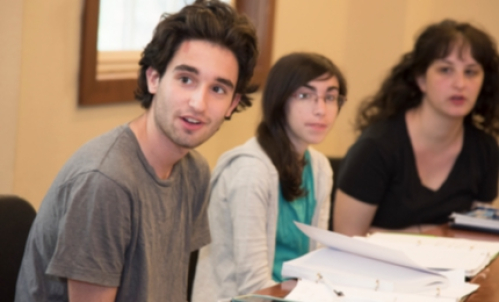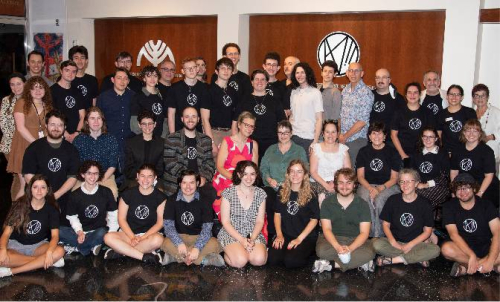Max Weinreich in Copenhagen
by BENT BLÜDNIKOW
In 1939, Max Weinreich, his wife Regina, and their son Uriel-Eliezer were stranded in Copenhagen, Denmark. Weinreich had been on his way to Brussels for a conference on languages with leading Danish linguists. But the outbreak of war put an end to his trip and he was forced to stay in Copenhagen while his wife traveled back to Vilna in order to care for the couple’s youngest child, Gabriel. We shall speak more of Max Weinreich and his stay in Copenhagen, but first, a few words on the East European Jews of Copenhagen.
Yiddish culture in Copenhagen
Beginning in the 1880s, large groups of Jews emigrated west from tsarist Russia. Most went to the United States but smaller groups made their way to Paris or London. About 5,000 Jews sailed from the Baltic ports to Copenhagen. In the poorest areas of town, they formed a ghetto where Yiddish was spoken and also performed on stage. In many ways, the ghetto of Copenhagen was similar to the Jewish environments that could be found in lower Manhattan or in the poor East End of London.
Many of the Jewish immigrants in Copenhagen would move on to New York, but around 5,000 remained in Denmark. Most of them were tailors, and also socialists and Yiddishists, and a very active environment sprouted in the beginning of the twentieth century. The Danish authorities were suspicious of the immigrants, fearing civil unrest and revolutionary activity, and the Jewish socialist movement, the Bund, an anti-tsarist movement, was indeed quite active in those years. But Denmark was a tolerant society, and up until 1912-1913, it was easy to gain a work permit there. However, in 1917, immigration laws tightened and the authorities tried to completely seal off Jewish immigration.
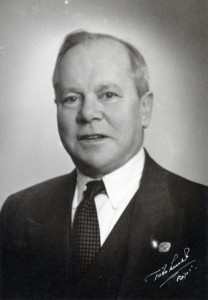 Abraham Krakowsky, ca. 1951. He died in 1958.
Abraham Krakowsky, ca. 1951. He died in 1958.My grandparents came to Denmark around 1910, and my grandfather Abraham Krakowsky was an eager Yiddishist who was in contact with Jewish authors and actors around the world. Following the Second World War, documentation of his activities for the Yiddish cause and those of others, as well, was sent to the YIVO Institute in New York, where it can be found in the Archives.
In 1927, Abraham Krakowsky and his friends, including Samuel Beilin, Abram Krotoschinsky, and the author Pinches Welner founded a Yiddish school with the mission of teaching young people the language. By 1929, there were 44 pupils who attended the Jewish girls' or boys' school in the daytime and the Yiddish school in the evening. (Yiddish was banned from the regular Jewish school, where emphasis was on speaking Danish. The Jewish community was dominated by affluent and well-integrated families who had arrived in the previous two centuries and they preferred that the new, poor Jewish families be integrated as soon as possible.)
Grandfather Abraham was married to a girl from Russia named Dora Chagall and they had three girls: Liebe, Perle, and my mother Henny. At home, they spoke Yiddish, and my mother remains a proficient speaker of the language, even to this day, at age 86.
The Jewish school was not fond of taking on Yiddish as a part of its curriculum but in 1931, 287 parents signed a petition to make the language part of the school’s activities. The request was accepted and a Yiddish evening school was attached to the regular schools and proved successful in attracting pupils.
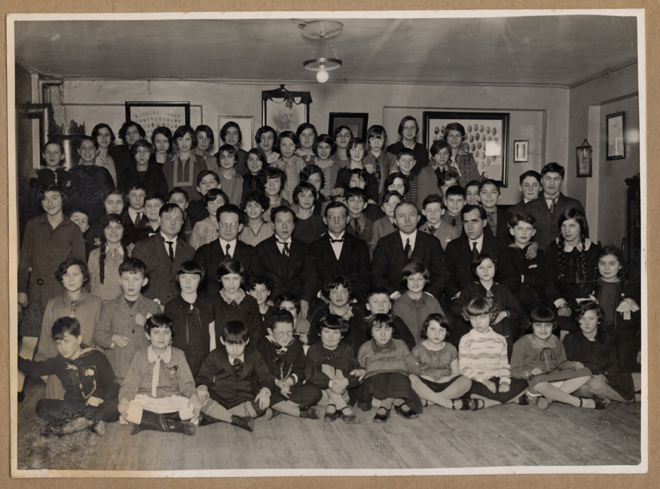 Yiddish school in Copenhagen, ca. 1930-32. Teachers, seated, from left: Pinches Welner, M. Beresowsky, Abraham Krakowsky and Samuel Beilin.
Yiddish school in Copenhagen, ca. 1930-32. Teachers, seated, from left: Pinches Welner, M. Beresowsky, Abraham Krakowsky and Samuel Beilin.Aside from the Yiddish school, the East European Jews were busy cultivating their cultural activities and the Yiddish theater was often visited by traveling actors, such as Morris Bilavski and Adolf Timianov. They performed all the classic Yiddish plays and there was also a Yiddish choir called Hasomir.
Max Weinreich in Copenhagen
Max Weinreich arrived in Denmark in mid-August, 1939. We can trace him and his family through the police archives. The national police had a department that kept tabs on all foreigners. Denmark was in a precarious position on the international stage and spies and revolutionaries were feared. During the First World War, the surveillance of all foreigners was intensified. It was tightened even further through the 1930s and so the Weinreich family fell under scrutiny when they came to Denmark in 1939.
Max was repeatedly summoned to the police. The documents allow us to follow his family through the months they were in Denmark. Police reports from October 13, 1939 state that Max Weinreich appeared and gave the explanation that he was born in 1894 in Kuldiga, Poland [sic]. His Polish passport was valid until September 19, 1940 and, in addition, he possessed a German visa due to expire on October 17, 1940. Finally, he also held a visa from the Danish legation of Warsaw from August 9, 1939 that permitted him repeated traveling before October 9, 1939.
Weinreich had arrived in Denmark on August 20 together with his son Uriel-Eliezer who was born on May 23, 1926 in Vilna. The plan had been for Weinreich to travel to the language conference in Brussels alongside two renowned linguists, Viggo Brøndal and Louis Hjelslev. The conference was scheduled to take place on August 29, but due to the tense political situation, their journey was first postponed and later entirely called off as the war got underway. Weinreich explained that his means of transportation back to Poland had been canceled and so he needed permission to stay in Denmark. He let it be known that he was a staff member at the institute of linguistics in Vilna and he requested that he be allowed to stay in the country until April 7, 1940.
Max’s wife Regina (born September 17, 1898 in Vilna) had originally come with him to Denmark, but as the situation became ever more risky, she went back to Poland by plane to care for their youngest son Gabriel, who had been left behind.
Max reported that Regina had forwarded his passport to him in Denmark. Vilna had been bombed by the Germans in September but he had received a telegram from her stating that she and their son were out of harm’s way. Vilna was later occupied by Russian forces and Weinreich had not heard from his wife since then.
He made it clear that he wished to remain in Copenhagen and wait out the course of events but that he ultimately intended on returning to Vilna. If Vilna fell under Russian rule, though, he would not go back but instead see to it that his wife and son would leave and meet up with him and Uriel-Eliezer. He declared that Denmark was not an appropriate place for his activities and that he would be able to get a residence permit in another country. At the moment, he was in possession of 300 dollars, forwarded to him from the United States, and he said that he could get more if need be.
On December 15, he appeared again before the police and explained that his wife had filed an application for an entry permit. The police wrote: “At the same time, he has filed an application for an entry permit through a lawyer. The necessary papers are the same as those which Polish subjects residing in Lithuania must present to acquire Lithuanian citizenship. He does not know when he will receive a response but he claims that the matter is formally under control and that it is just a matter of time.”
Uncertain future
Max and Uriel-Eliezer resided in the Hotel Royale on Halmtorvet, not one of the city’s best neighborhoods, and in a letter to the police dated February 14, 1940, Max wrote: “In a letter from December 6th 1939, I requested that my residence permit be prolonged for three months and these are now about to expire. I therefore apply for another month of extension as it has come about, as I expected when I filed my last request, that the procurement of the necessary circumstances for my travel cannot be expected in less than one month.” (This particular letter was in Danish. Weinreich must have had a Danish translator.) His request was permitted.
We know that Weinreich had connections to Jewish social circles during his stay in Copenhagen and we also know that on March 4, 1940, there was a gathering in the Jewish community center in the inner city of Copenhagen where people came together to wish him their farewell. Among those present were the individuals who ran the Yiddish evening school, such as Samuel Beilin, Pinches Welner, the sociologist Joseph Davidsohn (who would later commit suicide together with his wife during the escape of Jews to Sweden in October 1943), the Zionist Benjamin Slor, Abraham Krotoschinsky, and my own grandfather Abraham Krakowsky. An account in the Jewish weekly Jødisk ugeblad #15 from March 1940 notes that Krakowsky recited a poem dedicated to Weinreich.
Now it was time to get going. Denmark was occupied on April 9, 1940 by the Nazis and Max and Uriel-Eliezer were successful in leaving the country and reaching the United States just before the occupation became a reality and the borders were closed. They traveled to New York where they were reunited with Regina and Gabriel. Most Danish Jews miraculously escaped to Sweden in October 1943 and only 500 fell into the hands of the Germans. They were sent to the Theresienstadt (Terezin) concentration camp. During the exile in Sweden, Yiddish culture continued to flower, with plays and concerts regularly taking place.
When the Danish Jews returned to Denmark following its liberation on May 5, 1945, they rebuilt their community and the different Jewish associations, including a new one—a YIVO committee—resumed their activities. The close ties established with Max Weinreich in the 1930s inspired Danish Jews to gather historical, ethnographic, and cultural materials and forward them to the YIVO Institute in New York. In 1951, Abraham Krotoschinsky, who had become one of the leaders of the committee, wrote: “In spite of the contribution of the Danish YIVO committee being of a very insignificant kind, it has—thanks to the close contact to Dr. Weinreich—succeeded in forming a close working relationship with the organization in New York. Our work is often mentioned in the periodicals of YIVO as an example to go by for other Jewish cultural centers.”
The YIVO committee arranged lectures and concert evenings, one of the more exotic ones being the one in 1949, at which E.M. Trozki from Buenos Aires talked about Jewish culture on the other side of the equator. Following the lecture, my grandfather read aloud from the works of Der Tunkeler. [Yoysef Tunkel, a Jewish humorist.]
With the coming of the next generation, Yiddish culture in Denmark more or less ceased to exist. My mother does not remember Max or Uriel-Eliezer, as she was just a little child in 1939-1940, but she received Uriel’s winter coat as a hand-me-down, and wore it throughout the winter of 1940.
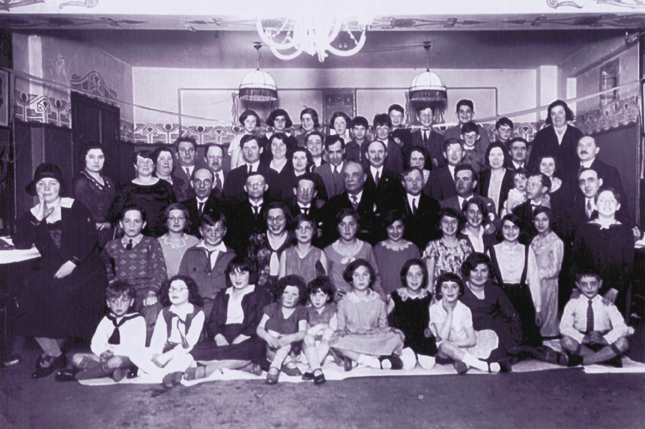 Yiddish school in Copenhagen, ca. 1930. (Right) Abraham Krakowsky with his daughter Henny, mother of the author, resting on his shoulder.
Yiddish school in Copenhagen, ca. 1930. (Right) Abraham Krakowsky with his daughter Henny, mother of the author, resting on his shoulder.
Read our Follow-up About the Denmark Jewish Community.
Bent Blüdnikow is a historian and journalist. Born in 1954, he was educated at the University of Copenhagen as a historian. For ten years, he worked in the National Archives of Denmark, where he became an archivist and senior researcher. In 1994, he became the Opinion Editor for the weekly newspaper Weekednavisen, and, in 1998, Opinion Editor for the daily newspaper Berlingske. He now works for Berlingske as a journalist. He has served as chairman of The Society for Danish Jewish History and editor of its yearbook, Rambam. Among his books are Som om de ikke eksisterede (As though they did not exist), about German Jews coming to Denmark in the 1930s (1996); Bombeterror i København (Bomb terror in Copenhagen), about Muslim terrorism in Denmark 1968-1990 (2010); and Min fars flugt (My fathers escape), about his father Benjamin Blüdnikow’s flight to Sweden in October 1943 (2013).
